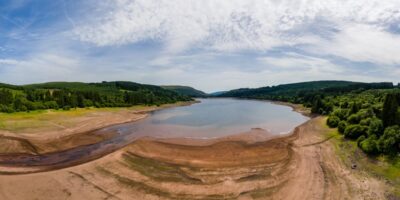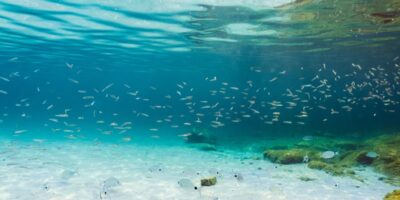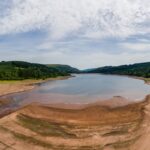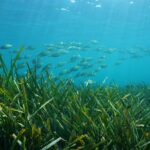The fight against climate change is no longer fought alone by NGOs and forward-thinking governments. As the consequences of climate changes become increasingly severe, we are seeing more and more private companies taking up net-zero pledges and aligning corporate processes to the UN’s Sustainable Development Goals (SDGs). But it can be a real challenge to find out which sustainability projects your company or organisation should invest in that will have tangible, positive impact on the natural world and in the fight against climate change.
My recommendation would be to invest in blue carbon ecosystem projects, which support not only SDG 14, ‘Life Below Water’ but also SDG 12 ‘Sustainable Consumption and Production’ as well as SDG 13 ‘Climate Action’. Here are five reasons why investing in blue carbon ecosystems is not only good for your company’s sustainability report but also for the planet:
- Blue carbon ecosystem projects are nature-based projects that focus on restoring the natural balance in marine ecosystems. Blue carbon specifically refers to carbon absorbed and stored in marine ecosystems such as tidal marshes, mangroves and seagrass beds1. This contrasts with conventional green carbon from terrestrial ecosystems like tropical forests. The exciting thing is that studies have shown that these marine ecosystems can store three to five times as much CO2 and sequester carbon at a rate ten times greater than mature tropical forests. One square metre of seagrass removes more than 200 grams from the atmosphere, which is more than triple the rate of carbon storage of an equivalent area of tropical rainforest and more than seven times the rate of storage in temperate forests2.
- Many blue carbon projects focus not only on conservation of specific marine ecosystems, but take it a step further with restoration of wetlands or seagrass beds as well as other natural areas such as tidal marshes. Such projects have the potential to remove more CO2 from the atmosphere than projects solely focused on conservation as the natural areas are restored, consequently expanding on the number of square metres reserved for natural habitats.
- Conserving and/or restoring blue carbon ecosystems also provides habitats for animals and plants, consequently lending critical support to biodiversity. For example, despite only covering 0.1% of the ocean floor, seagrasses play an important role in commercial fisheries3, providing nursery habitats to one-fifth of the world’s largest fisheries . Similarly, mangroves are important and diverse ecosystems that play an important role as nurseries for several marine species, including fish and shrimp4.
- More than 680 million people, or nearly 10% of the global population, live near the coast. These communities are 15 times more likely to be killed by floods and storms compared to other regions5. Restoration or conservation of blue carbon ecosystems such as mangroves or tidal marshes plays a crucial role in protecting coasts from increasingly violent storms and floods caused by climate change. This will in turn enable coastal communities to continue to thrive instead of being forced to move. Additionally, more than three billion people depend on healthy marine biodiversity for their livelihood6, through fishing and ecotourism. As such, by involving local communities from the project outset, blue carbon projects can also generate additional income through improved fishing conditions and sustainable tourism.
- Despite the importance of blue carbon ecosystems in terms of carbon absorption, biodiversity and coastal protection, these ecosystems remain some of the most threatened habitats in the world due to human actions. Anthropogenic causes of habitat decline include excessive nutrient run-offs into coastal waters which have led to algal blooms, dead zones and fish kills, ocean acidification7, and overfishing to name a few. By investing in blue carbon ecosystem projects, your company will be able to have real and positive impact on the balance in the natural world.
Where to start
Blue carbon ecosystem projects are still in the early stages of development, at least compared with more conventional land-based conservation projects. At the same time, there is increasing focus on high-quality carbon credits to ensure that carbon credit purchases have meaningful impact on the environment8. My recommendation is to do a quality check of the project before investing and perhaps involve an advisor with experience in blue carbon ecosystem projects9 to stress test the feasibility of the project. Detailed, high-quality data will be necessary to do health checks of proposed blue carbon ecosystem projects and ensure that the methodology is founded in solid science. Carefully assessing project criteria such as additionality, realistic and credible baselines, robust quantification and monitoring, permanence and avoiding double counting can help improve the quality of carbon credits.
As the interest in blue carbon ecosystem projects continue to grow, we will also see an increasing need for frameworks and guidelines for investment and development of science-backed projects and methodologies. I would thus recommend that you ensure your investment in blue carbon ecosystems has positive impact on the environment and local communities and ultimately empower the fight against climate change.
[1] The Ultimate Guide to Understanding Carbon Credits • Carbon Credits
[2] Understanding blue carbon | NOAA Climate.gov
[3] Why protecting & restoring blue carbon ecosystems matters | UNEP – UN Environment Programme
[4] Mangroves: nurseries for the world’s seafood supply | IUCN
[5] The ocean – the world’s greatest ally against climate change | United Nations
[6] Goal 14: Life Below Water – United Nations Sustainable Development
[7] Frontiers | Nordic Blue Carbon Ecosystems: Status and Outlook (frontiersin.org)
[8] https://carbonbetter.com/story/high-quality-carbon-credits/
[9] How to scale up blue-carbon projects – World Ocean Initiative (economist.com)








